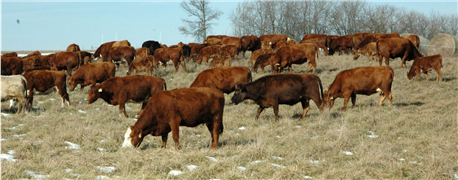
The New Year brings with it a new opportunity to improve beef herd management, according to University of Missouri Extension livestock specialist Gene Schmitz.
He says winter is the time to hone in on feeding programs, calf health and overall costs of a beef program. Schmitz offers these five key areas to improve your beef herd management skills in 2016:
1. Feeding programs. Schmitz says feeding programs need to be addressed during winter months, starting with hay. "Hay quality drives supplementation programs, and cannot be evaluated visually," he notes. "If the hay supply has not yet been tested, that is step one."

REVIEW 2015: It is always good to look back at what worked and what did not from the previous calf crop.
2. Cow body condition. Beef producers should assess cow body condition prior to calving. That according to Schmitz, is "the second puzzle piece." He recommends when possible to separate thinner cows from their better-conditioned counterparts and feed each group accordingly, based on hay quality determined by a hay test.
3. Feed costs. This the largest expense for cow-calf producers. To improve economics of the beef production enterprise, Schmitz says beef producers should take steps to develop feeding programs that fill nutritional holes in the most cost effective manner. Run cost scenarios including supplements to determine the best fit for your nutritional program.
4. Calf health. Scours can be a huge issue for beef producers. Schmitz says cattlemen can manage the issue using the Sandhill's Calving system. "The idea is to separate early born calves from later born calves, since many scour causing organisms are passed from older to younger calves," he explains. "As cows calve, they remain in a management group. On a weekly basis, cows that have not calved are moved to a new pasture area." The process continues throughout the calving season. Once calves are about 4 weeks of age, they co-mingle back with older calves.
Schmitz says the system takes planning. "So begin to think through how this management system could be incorporated into your operation if calf scours are a continual problem," he adds.
5. Production records. It is always good to look back at what worked and what did not from the previous calf crop. Determine if weaning weights increased, decreased, or stayed steady and try to figure out why these changes occurred. The key moving forward is to keep production records.
Schmitz recommends starting with calving records. There are a couple options, either record the total number of cows that calve each day of the calving season, or individually identify each calf and record its' date of birth and mother. Note that calving dates are important to assess herd weaning weight data. He recommends beef producers look at calving records by 21-day calving intervals to determine what percentage of calves were born in the first 21-day period, the second 21-day period and so on throughout the season. "The goal is to have most of the calves born in either the first or second 21-day calving period," he says. "This indicates good nutritional and reproductive management of the cow herd."
Schmitz adds that if the calving season is strung out beef producers should assess nutritional or reproductive management, bull productivity, and even weather during breeding season.
"The usefulness of production records cannot be overemphasized," he says. "However, simply collecting data is a worthless exercise. Records do need to be studied and the information they contain needs to be used in order for the effort to be worthwhile."
About the Author(s)
You May Also Like






